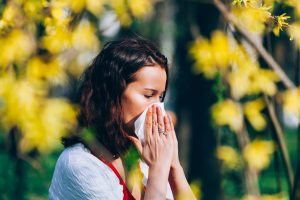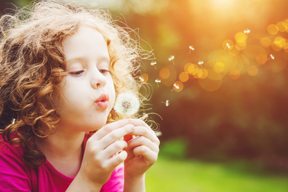 Aaahhh-choooo! It’s springtime in the Rockies, and that means allergy season.
Aaahhh-choooo! It’s springtime in the Rockies, and that means allergy season.
Although many people believe that allergy season started earlier than usual this year, that’s an annual complaint, said Dr. Stephen Dreskin, physician, teacher, lecturer, author of medical articles and Professor of Medicine and Immunology at the University of Colorado School of Medicine.
Dr. Dreskin has practiced for 40 years – in Colorado since 1989, and he has helped develop the Comprehensive Lung and Breathing Program at UCHealth University of Colorado Hospital. Over the years, he’s seen a few patients with allergies.
One reason that so many sufferers always think the season is here early is that “we have a pretty pollen-free winter and then, all of a sudden, the tree pollen goes from zero to 60 in a short period of time.”
This year, it may have started a bit earlier – mid-February as opposed to later in February, he admitted. “And the tree pollen does seem to be high this year.”

Almost every spring, he said, “People think this is the worst season ever.”
Compounding the situation this year is a spate of “significant spring respiratory viruses – and sometimes it’s hard to tell if you have a cold or allergies,” he added.
Although children and young to middle-aged adults often suffer in greater numbers than older adults, anyone can have allergies and anyone can get them at any time in their life.
“I just saw a patient the other day who never had any allergic symptoms his whole life and now, at age 40, he’s having fairly severe symptoms.”
Senior citizens often start to experience reduced allergic symptoms as their immune system becomes less active, he said.
What you’re allergic to often depends on where you live. If you live somewhere damp, with lots of water, you may become allergic to mold or dust mites. If you live in Colorado, where it’s relatively dry, there are no dust mites and mold is uncommon, so you’re more likely to become allergic to sagebrush and tumbleweed, or to indigenous trees, such as cottonwoods, aspens and junipers.
“You can only be allergic to something if you’re exposed to it,” he said.
It’s not uncommon for someone who lives elsewhere to come to Colorado on vacation and suddenly experience no allergies. The person may even move here for that reason. Then, a few years later, after becoming acclimated to Colorado, a whole new set of allergens may have to be contended with.
“It’s called the honeymoon period,” Dreskin said.
What’s more likely to cause seasonal allergies is the genetic component. If both your parents have allergies, chances are 60 to 70 percent that you will have allergies. If neither of your parents suffer from allergies, it’s more like 20 percent, Dreskin said.
What are the best treatments for common seasonal allergies?
He suggests starting with over-the-counter medications.
“Many of the medications that were prescriptions 5-10 years ago are so safe, they’ve been moved to over the counter. The best ones are antihistamines with a very low sedation side effect, called type 1,” including Zyrtec, Allegra and Claritin.
But don’t feel like you need to buy the name brands, he tells patients. “The generic are just as good and a lot cheaper,” he added. “You take them once a day. And few people have side effects from these.”
A second class of medications that may be good to try are nasal sprays, like Flonase, because they are low dose and topical. “Think of it like putting hydrocortisone cream on a skin rash.” Nasal sprays need to be used consistently and may take a few days to a week to have a full effect, though.
“These medications work best if taken in advance. They do not reverse the effects of what is already going on,” Dreskin said.
Nasal saline washes can help, too – used once or twice a day, they can help to keep seasonal allergies at bay. They also may help your medications be more effective, he added.
 “The great thing about that is it’s very inexpensive and non-medicinal. Even wearing a cloth mask you can get at the hardware store just to keep the dust and pollen out may help.”
“The great thing about that is it’s very inexpensive and non-medicinal. Even wearing a cloth mask you can get at the hardware store just to keep the dust and pollen out may help.”
For patients still having problems, despite reasonable medications, allergy immunotherapy is available. That would be shots or oral sublingual treatments (under the tongue). The latter features lower doses and are sometimes more difficult to tolerate (i.e., the patient can have a reaction). They are also less effective than are allergy shots.
“When we speak about allergy shots, we’re talking about a very effective treatment for allergic individuals, helping 60-70 percent of those who can complete a course of shots,” Dreskin said. “But it’s time consuming and slow to work. A complete treatment can take 3-5 years of monthly injections, so it’s a commitment.
“The positive effects may not be appreciated for a year. But it’s highly effective and, for 30-50 percent of patients, it puts seasonal allergies into complete remission.”
Left untreated, seasonal allergies can incite other health issues.
“They affect not only the nose; they affect the eyes and lungs, too. The thing we most worry about is having it develop into an asthma attack for a patient with underlying asthma.”
Seasonal allergies can have profound effects on the body, including fatigue, difficulty thinking or interfering with sleep.
Allergies also can develop into a sinus infection. And although allergies do not cause pneumonia directly, “those with severe allergies do have an increased frequency of getting pneumonia,” he said.
After years of tending patients and studying the phenomenon, Dreskin concludes that “allergies seem to becoming more prominent in our modern world.”
Seasonal hay fever was relatively rare in the 19th century, but now affects 20-30 percent of the population, he added.
“There are lots of theories out there as to why,” he said. “One hypothesis is that we are ‘too clean’ – protected against infectious diseases by modern plumbing, better hygiene and changes in how children play.
“Food allergies are also increasing in prevalence. But almost everyone with food allergies also has hay fever. Somehow, there’s a link.”
He counts himself lucky not to suffer from allergies.
“I’m an unusual allergist in that I’m not allergic to anything.” Dreskin said.
“Of course, the word allergy has lots of different meanings to different people. People will say, ‘I’m allergic to milk,’ when actually they’re lactose intolerant. Or they’re sensitive to something and call it an allergy.
“When a physician thinks of allergy, they think of a specific reaction to something.”
But most people are on the same page when talking about seasonal allergies. Once they experience the itchy eyes and nose, sneezing, drainage and such, they’ve identified it pretty clearly.
The good news is, along Colorado’s Front Range, there’s usually a respite in July, after the spring pollens and before the fall allergens. There’s another break from late October (after the first snow) till some time in February. And if you have seasonal allergies, know that they are at their worst mid-day, so if you want or need to be outside, early morning is a good time to do that.
Stay on top of your medications. Follow pollen counts on a weather station and check out the many possible solutions in your pharmacy. With any luck, you’ll find one that works for you. If not, see your physician for help.
